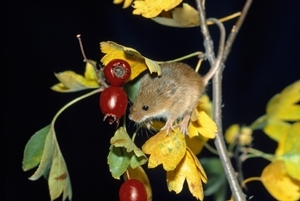Harvest mouse (Micromys minutus)
 It was Hampshire’s Gilbert White who first accurately described the harvest mouse as a distinct species in 1767. In one of the letters he wrote to a fellow naturalist that year he says: “I have procured some of the mice mentioned in my former letters, a young one and a female with young, both of which I have preserved in brandy. From the colour, shape, size and manner of nesting, I make no doubt but that the species is non-descript.”
It was Hampshire’s Gilbert White who first accurately described the harvest mouse as a distinct species in 1767. In one of the letters he wrote to a fellow naturalist that year he says: “I have procured some of the mice mentioned in my former letters, a young one and a female with young, both of which I have preserved in brandy. From the colour, shape, size and manner of nesting, I make no doubt but that the species is non-descript.”
Harvest mice range in colour from yellowy brown to a russet orange and are very small, measuring only 5-8cm in length and weighing just 6g – which is less than a two pence coin! They are the only true example of a species in this country with a prehensile (capable of gripping) tail and literally use it as a fifth limb. Their range in this country is restricted to counties from Yorkshire southwards, but they are also found across most of Europe into southern China.
The diet of this tiny mammal is mainly vegetarian and consists of seeds, fruit, bulbs, roots and fungi, although it does eat some insects during the summer months. It will store food in its winter underground nest for times of bad weather, as unlike the dormouse, harvest mice do not hibernate. It is, however, the summer nests that they build that often give their whereabouts away, as these are usually positioned around knee height in vegetation around the edge of fields or in reed beds. These spherical nests are made by the pregnant female and consist of woven grasses ranging from 5cm (resting nests) and 10cm (breeding nests) in diameter, so on average are about the size of a tennis ball. The young, usually four to eight in number, are born between May and October and the mother will often go on to have a total of three litters a year, building a new nest for each one.
The best time of year to look for these nests is between September and January, when the vegetation dies back in the field boundaries, but before the winter storms dismantle the nests. I usually come across them placed in tussocky grasses, especially where a nest can be “supported” by a bramble or little bit of scrub. If you are out for a walk this autumn, why not see if you can find one as they are a real marvel!
Although Gilbert White pickled some of the harvest mice he caught, he also showed a caring side to his nature as well, worrying, for instance, “how could the dam come at her litter respectively so as to administer a teat to each”, such were his concerns over such a tiny nest containing up to eight young. He also wrote so descriptively, about his observations, for example when he said “this wonderful procreant cradle, an elegant instance of the efforts of instinct, was found in a wheat field suspended in the head of a thistle”.
Peter Thompson
Advisory

Download Peter Thompson's essential 26-page book, featuring beautiful photography and detailed profiles of Britain's wildlife
Download FREE >